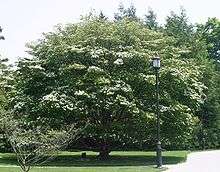Cornus kousa
| Cornus kousa | |
|---|---|
 | |
| Scientific classification | |
| Kingdom: | Plantae |
| (unranked): | Angiosperms |
| (unranked): | Eudicots |
| (unranked): | Asterids |
| Order: | Cornales |
| Family: | Cornaceae |
| Genus: | Cornus |
| Subgenus: | Syncarpea |
| Species: | C. kousa |
| Binomial name | |
| Cornus kousa F.Buerger ex Hance | |
| Synonyms | |
| |
Cornus kousa is a small deciduous tree 8–12 m (26–39 ft) tall, in the family Cornaceae. Common names include Japanese dogwood, kousa, and kousa dogwood. Synonyms are Benthamia kousa and Cynoxylon kousa.[1] It is a native plant to East Asia including Korea, China and Japan.[2] Widely cultivated as an ornamental, it is naturalized in New York State.[3]
Description
Like other Cornus, it has opposite, simple leaves, 4–10 cm long. The tree is extremely showy when in bloom, but what appear to be four, white petals are actually four spreading bracts below the cluster of inconspicuous yellow-green flowers. The blossoms appear in late spring, weeks after the tree leafs out.
It can be distinguished from the flowering dogwood (Cornus florida) of eastern North America by its more upright habit, flowering about a month later, and by the pointed rather than rounded flower bracts.
The fruit is a globose pink to red compound berry 2–3 cm in diameter, though these berries tend to grow larger towards the end of the season and some berry clusters that do not fall from the tree exceed 4 cm. It is edible, a sweet and delicious addition to the tree's ornamental value. The fruit is sometimes used for making wine.[4]
It is resistant to the dogwood anthracnose disease, caused by the fungus Discula destructiva, unlike C. florida, which is very susceptible and commonly killed by it; for this reason, C. kousa is being widely planted as an ornamental tree in areas affected by the disease.
Fall foliage is a showy red color.
Varieties, hybridsm and cultivars
A number of hybrids between C. kousa and C. florida have been selected for their disease resistance and good flower appearance. Varieties include:
- Cornus kousa Hance subsp. kousa, or Japanese dogwood, native to Japan and Korea. [5]
- Cornus kousa Hance subsp. chinensis or Chinese dogwood, native to China.[6]
- The cultivar C. kousa 'Miss Satomi'. The validity of this variety, however, is questioned according to the University of Connecticut Plant Database. The selection Milky Way is one of the most common cultivars in the trade, probably composed of over a dozen similar clones. It is extremely floriferous and sets a very heavy crop of fruit.[7]
- Satomi, with pink bracts, and Wolf Eyes, a variegated form are popular.[7]
Photo Gallery
| Wikimedia Commons has media related to Cornus kousa. |
 Flowers
Flowers Foliage and fruit
Foliage and fruit Fruits
Fruits Fruit cut in half.
Fruit cut in half.- C. Kousa flowers in the UBC Botanical Garden
References
- ↑ "The Plant List". Kew Gardens. Retrieved 9 July 2016.
- ↑ "Cornus kousa". U.S. National Plant Germplasm System. Retrieved 9 July 2016.
- ↑ "Chinese dogwood". Bernheim Arboretum and Research Forest. Retrieved 9 July 2016.
- ↑ "Cornus kousa subsp. chinensis" at eFloras.org. Retrieved 1 July 2011.
- ↑ "Cornus kousa Hance subsp. kousa". U.S. National Plant Germplasm System. Retrieved 9 July 2016.
- ↑ "Cornus kousa Hance subsp. chinensis". U.S. National Plant Germplasm System. Retrieved 9 July 2016.
- 1 2 "Cornus kousa". UCONN. Retrieved 9 July 2016.